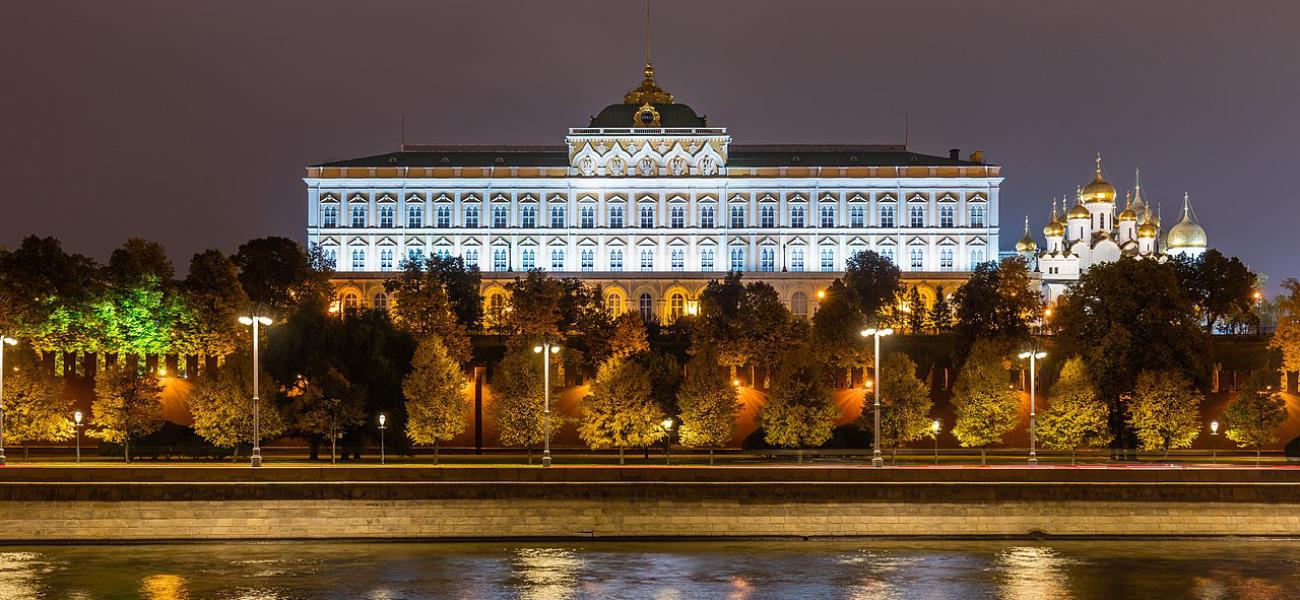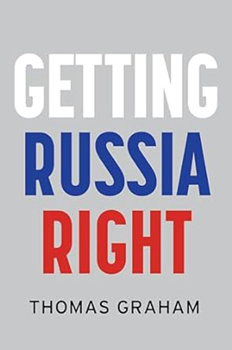
Thomas Graham on Why and How America Should Start Getting Russia Right
BOOK REVIEW
“Getting Russia Right”
By Thomas Graham
Polity, October 2023
Multiple books have been published since Vladimir Putin’s re-invasion of Ukraine in February 2022 that explore the sources of Russia’s aggressive conduct. In fact, some of these books were rushed to hit the shelves of digital and brick-and-mortar stores less than half a year after Russian tanks started rolling toward Kyiv on Feb. 22, 2022. Thankfully, Thomas Graham, who has been among the most thoughtful of the Western world’s Russia experts for decades, took his time, “Getting Russia Right.”1
In his effort to understand the behavior of today’s Russia and illustrate the continuity of the Russian leadership’s immutable interest in the survival of the state, this distinguished fellow at the Council on Foreign Relations goes as far back as the days of Rurik’s descendants ruling the Principality of Moscow in this 272-page volume.
However, while centuries of Russian history clearly matter for getting today’s Russia right in Graham’s view, it is the post-Cold War period that he takes the hardest and longest look at, striving to ascertain what has shaped Russia’s and America’s policies toward each after the disintegration of the Soviet Union.
Graham asks two key questions regarding that period in U.S.-Russian relations: “How did we get to this point? Where do we go from here?” He then makes two key claims to shine light on what the answers might be. The first claim is “that, to defend its long-term strategic interests, the United States must treat Russia as a great power, which entails, as all great-power relationships do, making trade-offs and compromises to manage the inevitable competition responsibly.” The second claim is “the integration model, the premise that Russia could join the West, ultimately failed because it was, and remains, incompatible with the deeply held national aspirations and policy imperatives of both the United States and Russia,” according to Graham.
Graham’s incisive post-mortem of this failure and other outcomes of the post Cold-War policies pursued by America and Russia toward each other indicates that both structure and agency have mattered a great deal.2 In particular, he sees a number of structural factors behind the failure of America’s grand strategy of integrating Russia into the Euro-Atlantic Community as a free-market democracy and the subsequent deterioration of U.S.-Russian relations. One such factor is the aforementioned divergence of Russia’s and America’s deeply held national aspirations and policy imperatives. Other long-term factors are “clashing worldviews and national missions ... [which] ... inevitably injected a lasting element of tension in relations, which was exacerbated by U.S. actions and Russian reactions,” according to the author. At the same time, Graham sees agency impacting relations as well, arguing that Bill Clinton, George Bush Jr. and Barack Obama have all contributed to the failure of America’s grand strategy toward Russia by discrediting the idea of a Western-style democracy in Russia. “The goal of integrating Russia into the Euro-Atlantic Community was not necessarily unrealistic, but the timeframe certainly was,” he writes, noting that it would have taken more time than the U.S. had patience for to convince post-Soviet Russia’s elites that they and their country would benefit from arrangements proposed by the U.S. and its allies. In addition to blaming America’s post-Cold War leaders in general for failing to display “strategic patience” when pursuing Russia’s integration, Graham also faults individual U.S. presidents. In particular, he blames Bush Jr. for alienating Putin by failing to “repay Russia in kind” for its post 9/11 help, and Obama for undermining Medvedev over the U.N.-authorized intervention in Libya. “There was nothing foreordained about the depths of antagonism that divide the two countries today. There was another pathway forward, toward, if not strategic partnership, then more constructive relations of mutual benefit, which would have required the United States to respect Russia as a great power. Taking it would have, however, required greater clarity of vision, imagination and political will than successive American administrations could muster at the time,” Graham writes, explaining how agency led to erroneous policies toward Russia. Needless to say, Graham also blames Putin for contributing to the demise of the relationship by committing a number of policy mistakes. Putin’s biggest blunder was his decision to reinvade Ukraine, according to Graham, who served as special assistant to the president and senior director for Russia on the National Security Council staff from 2004 to 2007. “Putin chose war ... moving beyond the contours of Russia's traditional strategic framework to pursue personal goals,” Graham writes. Putin’s “profound concern about Russia's security” was broadly shared by the Russian elite, but combined in him “with unique personal characteristics such as hubris, a thirst for vengeance, the determination to rectify an historical injustice, [excessive] ambition and messianic impulse,” Graham writes, ultimately leading to war.
Based on these findings, Graham then predicts how the U.S.-Russian interaction will evolve in the years ahead. He argues that three issues will dominate it. The first one is strategic stability. “Strategic stability will have to be based on an interlocking network of bilateral and multilateral arrangements, understandings and codes of conduct and unilateral initiatives undertaken in the hope that other states will emulate them,” Graham predicts. “No two states have deeper experience in conceptualizing strategic stability than Russia and U.S., and their joint efforts will be critical to developing a future framework for it.” “That should be reason enough for Washington to revive and sustain strategic stability talks with Moscow,” he writes.
The second issue to dominate the U.S.-Russian relationship will be European security, according to Graham, who combines years of experience as a practitioner with decades of scholarly research, most recently at Yale, where he is the cofounder of the Russian, East European and Eurasian studies program and a lecturer, teaching courses on U.S.-Russian relations and Russian foreign policy. “The immediate question is whether Europe's security architecture needs to be designed to protect the continent from Russia over the long term, or whether it might prove possible to build that architecture in cooperation with it, especially once the acute phase of the war in Ukraine has passed,” he argues. “There will be no enduring security without Russia's participation,” he predicts, arguing that “the long-term goal should be the resurrection of a security system based on cooperation with Russia.” Such a system could be built within the framework of a Helsinki-2, updating and reinterpreting “the 10 original Helsinki principles to take into account current geopolitical realities and technological capabilities,” in Graham’s view.
Graham predicts that “Ukraine in the strategic context” will be the third issue on the bilateral agenda. In his view, attaining armed neutrality for Ukraine is essential, but “NATO should put on hold for an indefinite period any further expansion eastward into the former Soviet space to avoid further provoking Russia at a time when Europe’s energies should be focused on consolation within NATO and the EU, as a way of deterring Russian adventurism.” “It should also be clear by this time that the United States will have to engage in direct, substantive negotiations with Moscow to end the conflict; this is not something that can be left to bilateral talks between Kyiv and Moscow” for “only Moscow and Washington wield sufficient power to alter the balance in Europe, and only they can guarantee the implementation of any agreement,” according to Graham. The author also advocates referenda for deciding the status of disputed territories and urges prosecuting war crimes, but makes clear that not everything on Ukraine’s list of demands is attainable. “Victory, Washington should stress, will come not by defeating Russia but with the emergence of a strong, prosperous, democratic Ukraine, anchored in Europe,” he argues. “No matter what happens, however, the critical strategic question of relations between Russia and the West will endure. Ukraine is but a small question of relations of that bigger equation,” Graham argues.
As for dealing with Russia itself, “Washington cannot afford to wait for the emergence of more desirable leaders” in Moscow, argues Graham, whose continuous understanding of the Kremlin’s thinking is in part based on his participation in Track 2 meetings with prominent Russians. Regardless of who is in the Kremlin, “the challenge for the United States is not to defeat Russia, ... but rather to skillfully exploit relations with a rival to construct a new global equilibrium that advances American interests,” according to Graham.
Looking forward, Graham sees a two-fold challenge in dealing with Moscow: “defeating the Russian assault on the European order in the short term, while preparing the ground for relations that will enable the United States to interact with Russia as a major pole of power in the emerging polycentric world, to construct and sustain a long-term complex global equilibrium and to deal with transnational threats.” To tackle this dual challenge, the U.S. needs to get Russia right, which requires America to see Russia “plainly and without sentiment,” according to Graham, who ends his book with the prediction that “Russia will never be the strategic partner the United States once hoped for. But neither must it remain the unrelenting adversary it is today.” I agree.
Footnotes
- According to his book, Graham began drafting it shortly after the beginning of Russia’s invasion of Ukraine on Feb. 24, 2022, while the final chapter was drafted as Ukraine recaptured the city of Kherson.
- That the author sees both agency and structure at play follows, among other things, from the following observation he makes: “In other words, does the United States today confront a Russia problem or a Putin problem? The answer is likely a bit of both. That said, getting the proportion right is critical to successful policymaking.”
Simon Saradzhyan
Simon Saradzhyan is the founding director of Russia Matters.
The opinions expressed herein are solely those of the author. Photo by Diego Delso shared under a CC BY-SA 4.0 DEED license.

